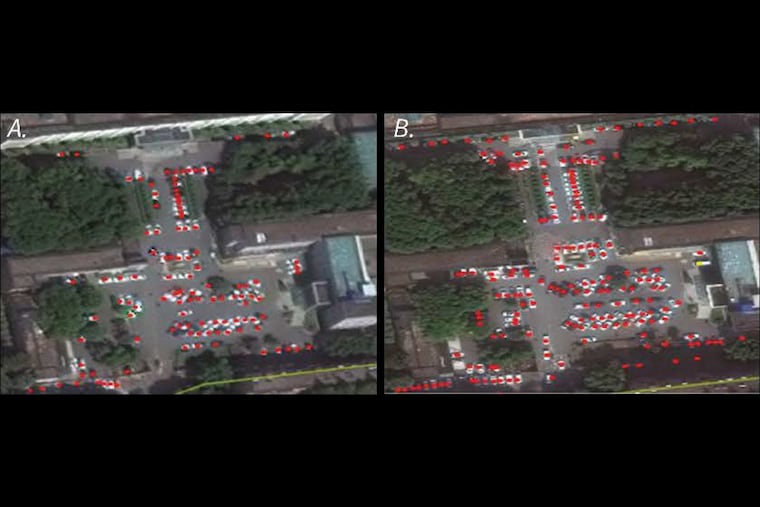Satellite images from China suggest coronavirus began spreading in October, researchers say
Chinese officials have pushed back against the study, calling it "extremely ridiculous."

Satellite images of hospital parking lot traffic suggest the coronavirus may have originated as early as October, two months earlier than in the official account from Chinese authorities, according to scientists at Boston Children’s Hospital and Boston University.
That conclusion was further supported by an analysis of internet search traffic for the Chinese words for cough and diarrhea, the authors wrote.
The research has not yet been published in a peer-reviewed journal, and therefore should be viewed as preliminary. But the use of these two kinds of traffic — automobile and internet — is a plausible approach, said Paul Digard, professor of virology at the University of Edinburgh, who was not involved in the study.
“Using search engine data and satellite imagery of hospital traffic to detect disease outbreaks is an interesting idea with some validity,” he told Science Media Centre, a science communications nonprofit.
Chinese officials, who have been accused of being slow to disclose information about the virus, rejected the findings. At a news briefing Tuesday, a spokesperson for the country’s foreign ministry called the analysis “incredibly ridiculous,” Reuters reported. The first known case occurred in early December, the government says.
Still, the country’s original accounting was flawed in at least one respect, the head of the Chinese Center for Disease Control and Prevention told the Wall Street Journal in late May: The virus does not appear to have jumped from animal to human at the live-animal market in Wuhan. While most of the initial cases were identified in patients who had spent time at the market, 14 had no direct connection.
Boston Children’s epidemiologist John S. Brownstein, senior author of the new satellite study, agreed.
“That Wuhan market may have been an innocent bystander,” he said.
The scientific consensus remains that the virus jumped to humans from a wild animal, not as the result of an accident with laboratory animals in China, as some U.S. government officials have alleged. Genetic evidence suggests the virus spread from a bat to an intermediate species before infecting humans, though its true origin may never be known with certainty.
A clearer picture of the timeline, on the other hand, may be within reach. Researchers have tackled that question in various ways, such as analyzing the genetic code of various strains of the virus. Several studies suggest it originated weeks before the Chinese government says it did, in early December.
Brownstein and his colleagues analyzed commercial satellite images of six hospital parking lots in the Wuhan area.
The number of parked cars increased markedly in early October, as compared with the same month a year earlier, said Brownstein, who also has an appointment at Harvard Medical School. Vehicle volume then dipped below normal in January and February, coinciding with China’s coronavirus lockdown, he said.
Internet search traffic for cough and diarrhea also increased during the fall, he and his coauthors found. Searches for cough coincided with a rise in influenza, but there is no known explanation for a rise in diarrhea besides COVID-19, he said.
Digard, the Edinburgh professor, cautioned that a more thorough analysis would have included satellite images and search traffic from elsewhere in China. Another limitation: Satellite images were not available prior to 2018.
Brownstein agreed that more research is needed.
“The idea of this study was to try to add another data element to try to help build the story,” Brownstein said. “It’s not definitive, but it provides this new area of evidence to dig deeper into.”